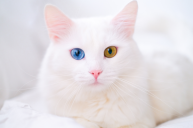A tortoiseshell breed of cat doesn't actually exist!
Did you know that the tortoiseshell cat breed doesn't exist as a specific breed of cat? The patterned coat color, not the breed, distinguishes a tortoiseshell. This means that many cat breeds can also be a tortoiseshell! The tricolor tortoiseshell pattern of the coat coloring, not the breed, distinguishes a tortoiseshell coat. The colors in their coats are either "bridled," which makes them appear to be braided together, or "patched," which means the colors form in huge patches all over the body. Tortoiseshell markings may be seen on many different breeds of domestic cats, such as the American shorthair, British shorthair, Cornish Rex, Persian, and Maine Coons.
Brief History of Tortoiseshell Cats

Tortoiseshell cats, often known as money cats, are a well-known emblem of good fortune in many cultures worldwide. Unlike black cats, male tortoiseshell cats were considered a symbol of good luck. the Y chromosome required to be a male coupled with the XX sex chromosome required for the tortoiseshell coloring means that male tortoiseshell kittens are extremely rare. The Ancient Celts found fortune with the uncommon male tortoiseshell, and if one stayed the night, householders were rewarded with good luck. Japanese fishers also believed in the male tortie's abilities, bringing them on board their ships to protect them from apparitions and storms. Rumor has it that if you dream of one of these beauties, love will come your way.
Before the 1970s, tortoiseshell was a high-end material used to make eyewear and home décor items. Because tortoise species were devastated globally due to excessive demand, the material's use was prohibited, and synthetic tortoise was produced. The cat's coat is named after this material because its coat pattern, color combination, and coloration are similar.
Tortoiseshell cats are known to have a sassy and somewhat feisty attitude, which was immediately nicknamed "tortitude." Anecdotally, many tortie owners agree that their cats are energetic, feisty, and even a little aggressive. When veterinarians from the University of California, Davis polled over 1,200 cat owners, they discovered that cats with calico and tortoiseshell coats are more likely to hiss, bite, swat, pursue, or scratch when interacting with people. Tortitude is an excellent description of this diva disposition.
Appearance

Tortoiseshell fur has been seen on the Maine Coon, Cornish Rex, Persian, and Ragamuffin breeds. The patterned coat, not the breed, distinguishes a tortoiseshell. Even mixed-breed cats, including domestic short, medium, and long hairs, as well as tabbies, sport this opulent coat.
Tortoiseshell coats are often ginger red, and black, although they can also include traces of cream, orange, or gold. Torties whose tortoiseshell markings are shown in bigger portions are referred to as "patched," while those whose colors intertwine are referred to as "brindled." Colors can either be interwoven throughout the body (mosaic) or divided (one half of the cat's body is one color, and the other is another). The division might also be between the face and the body. These cats can even come in a dilute tortoiseshell variety, which is a rare coat color resulting in more muted colors.
Because of their similar coat hues, many people confuse tortoiseshell cats with calico cats. Tortoises come in various hues and patterns, but the most common are ginger and black with hints of white, orange, gold, or cream and may have white markings. Calicos, on the other hand, have a white fur foundation with tortoiseshell color patches on top.
A tortie's color pallet might be patched or brindled, which means that the hues have been blended. Tortoiseshell cats also appear in tabby cats, with tabby pattern stripes known as "torbies." Torties can have a chimera look, where one side of the body is one color, and the other side is a different color. This generally appears as a half-black, half-ginger face, but it may appear in various hues all over the body.
A tortie cat has a one-in-three thousand chance of being male. That indicates that more than 99.9% of all tortoiseshell cats are female cats. The cat's X chromosome is responsible for the orange and black coat color pattern that is the foundation of a tortie's coat. Because females have the XX chromosomal pattern, their two Xs can co-dominate and result in a tortie kitten. Males cannot be tortie since they have the XY chromosomes UNLESS they suffer a genetic mutation and grab another X, resulting in an XXY pattern. Torties are primarily, but not completely, females.
Tortoiseshell cats are entirely based on their coat color, meaning that they can be purebred, long-haired, short-haired, a Japanese bobtail, Siamese or any mix of cat breed. Their lifespan and health issues come down to what their breed is, meaning that you have many options when looking for a beautiful tortoiseshell cat.
Do have a tortoiseshell cat? Share on the Wide Open Pets Facebook page!




